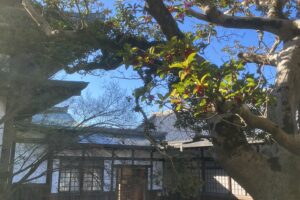Easter 2nd, April 16, 2023
Victim Consciousness and Its Dangers Donald Seekins
In the Gospel of Matthew (10: 16), Jesus tells his disciples: “behold, I send you out as sheep in the midst of wolves; so, be wise as serpents and innocent as doves.” In the Bible, serpents are often identified with evil. But in the ancient world, serpents were also believed to possess great wisdom, a wisdom that ordinary humans could not or would not acquire. On the rod of Asclepius, the Greek god of healing, is entwined a single serpent, used today as a symbol for the medical profession.
Part of wisdom, I believe, is identifying those states of our own consciousnesses that may prevent us from reaching the truth about something, and may motivate us to do bad things. Purposeful ignorance about a state of affairs is, in a sense, a sin. Why? Because it can make us preoccupied with the sins of other people rather than our own.
For example, the hatred of Japan expressed by some South Koreans is seen by many Japanese as including all South Koreans, but in fact the “hate Japan” movement in its various manifestations reflects divisions within Korean society, especially attacks on post-war South Korean elites who were seen as collaborators with Japanese colonialism. Japanese rule along with the rigid Yi Dynasty caste system created a class society that endures to this day.
The remarks that follow may seem roundabout, but I wish to discuss what is known in Japanese as giseisha ishiki, or “victim consciousness.” This state of mind is not simply one of feeling, at a point in one’s life, that one has been taken advantage of or treated unjustly: for example, being cheated of ¥100,000 by an internet con-man or being denied entry to a bar because of being a foreign resident. It is, rather, a vital part of one’s perceived existence in the world. The victim sees himself or herself as perpetually being taken advantage of, often because of membership in a certain racial, ethnic or gender category. The person deeply afflicted by victim consciousness often turns himself or herself into a passive but deeply resentful and dangerous object. Like a ticking time bomb. It can be a “mental illness” which hardens the boundaries between Us and Them.
Look, for example, at the endless cycles of violence in Northern Ireland or Israel-Palestine. They are powered by deep resentment and giseisha ishiki.
When I was a boy around twelve or thirteen years old, my parents took me to see Fort Ticonderoga, a place in northern New York State which played an important role in both the French and Indian War and the American War of Independence in the 18th century. You may not know that the former was a conflict between France and Britain in which Britain triumphed, forcing the French king out of his colony of “New France” in what is now eastern Canada but leaving behind a population of French-speaking Canadians, especially in Quebec.
During the mid-18th century, the thirteen British colonies of North America contained about two million British (or white) subjects, while New France had only 60,000 subjects of the French king. These figures did not include the indigenous populations. Unlike the British, who could depend on a large population of British subjects to fill the ranks of their army (including George Washington, who started his military career as a British officer), the French had to enlist large numbers of local Native Americans to fight their European enemy, and several Indian tribal groups played a major role in French campaigns against British North America.
When my parents and I visited Fort Ticonderoga in the 1950s, I remember quite clearly that its small museum contained a wooden dining table, which – even after two centuries – was stained with blood and the marks of axes. The staff explained to us that this table had belonged to a family of British settlers. As they sat down to their meal, they were attacked by Indians – apparently allies of the French – and massacred. We were invited by the planners of the exhibit to imagine vividly in our minds this horrid incident: a peaceful family settling down to an hour of food and intimacy, probably saying grace before eating. The door of their cabin flies open and in rush half-naked, painted savages carrying tomahawks, who proceed to cold-bloodedly murder them, including the children.
No doubt these massacres did occur. After all, the Indians, whose lands were progressively being taken over by white, mostly English, settlers, did not simply give up in the face of encroaching colonization. To have a more balanced view of the history, the Fort’s exhibit perhaps should have included one of the blankets infected with smallpox which the British general, Jeffery Amherst, distributed to unknowing Indians in what is now the US state of Ohio, one of the earliest examples in modern times of biological warfare. And the Indians of old New York, New England and Canada were a warlike people, much like the Aztecs of Mexico whose civilization was destroyed by the Spanish in the 16th century.
Visitors to the Ticonderoga museum were invited to see the British (later American) settlers as victims, and the “settling” of North America as the noble endeavour of bringing the light of Civilisation and Progress to the “dark” American continent. Seeing the settlers as innocent victims legitimized viewing the Native Americans as mindless monsters, an image easily transferred to other continents and times, as the Anglo-Saxon (and French) colonizers “pacified” huge swaths of Africa, Oceania and Southeast Asia.
Note that I am not saying that the settlers killed by the Indians were not victims, at least in many cases. Or, that they deserved to be killed (although we know some of the settlers had beforehand massacred Indians).
Sadly, victim consciousness has become deeply rooted in the collective consciousnesses of East Asian people, especially in (South) Korea and Japan. Yi Shunshin, the Korean admiral who defeated the invading Japanese navy in the late 16th century, is an admirable historical figure. He died on the deck of his ship in one of many battles, but he was never a victim. Although he remains a (South) Korean national hero, a newer image of Korea in relation to Japan has emerged in recent years: the “comfort girl,” whose statue can be seen in many places, including close to the Japanese embassy in Seoul. These statues have also appeared in some parts of the United States, funded by Korean-Americans. Wearing traditional Korean dress, she is a passive, innocent victim, one who stoically awaits a horrible fate. And she is not a specific, historical figure, but a symbol of Korean suffering at the hands of the Japanese militarists. A generic symbol, but one with immense psychological power.
Perhaps church is not an appropriate place to bring up politics, but a former Japanese prime minister’s attempts to whitewash the histories of the comfort women and Korean slave laborers are in my opinion despicable, especially since Germany’s leaders over the decades have been brave enough to tell the truth about their country’s crimes against humanity. His favourite expression – “Beautiful Japan” – is preposterous. Even Vladimir Putin wouldn’t say that his country is “Beautiful Russia.” At the same time, the image projected by the comfort girl statues is cut off from the historical context, in a manner similar to Hollywood images of white settlers being murdered by sadistic Indians.
For example, both Korea and Japan were (and remain today) deeply patriarchal nations: in both Korean and Japanese culture, women have been systematically denigrated over the centuries. It is doubtful that the Korean elites who collaborated with the Japanese colonial government, especially those from the Yangban class, cared very much about the fate of the comfort women, who were mostly the daughters of poor farmers. In fact, many of the girls must have been abducted by Korean gangsters. But all this ambiguity seems to be erased by the statues and their ubiquity.
All of us are familiar with the comfort women, but may be unaware of the fact that thousands of poor young Japanese women were abducted or sold by their parents and sent to Southeast Asia to be prostitutes. During the late 19th and early 20th centuries, these prostitutes, known as Karayuki-san, were found just about everywhere, from Singapore and Rangoon to Honolulu, Australia and even Siberia. At the time, some Japanese called them the josei-gun, or “women’s army,” because they earned foreign exchange that Japan needed. In the light of the history of the Karayuki-san, one could understand the wartime comfort women not as an issue between Koreans and Japanese, but as one of powerful men (and women) who profited from the suffering of poor, powerless women.
Next month, Prime Minister Kishida will meet in Hiroshima with fellow leaders of the G-7 nations. Without doubt, he will mention that Japan is unique in being the only country to experience atomic bombing. The victims of Hiroshima and Nagasaki certainly suffered horribly, and many of them since 1945 have worked heroically to achieve the goal of a universal ban on nuclear weapons. However, many Japanese depictions of the atomic bombings bother me. They focus on the innocence and helplessness of, for example, Japanese school children who were killed or maimed by the bombs (while Korean hibakusha stilltend to remain invisible). Many Japanese tend to forget (or, are encouraged to forget) that before August 1945, Chinese school children were killed by Japanese bombs – not atomic bombs, but lethal nonetheless.
Without context and disconnected from the complexities of history, victim consciousness is dangerous because it fosters limitless resentments. If you look at the truly horrible episodes in modern history, resentment is always there as a prime cause. It fuelled the career of Adolph Hitler whose virulent hatred of Jews and Slavs led to the murder of millions in World War II; and the Japanese militarists who felt humiliated because the “white” colonial powers didn’t consider them an equal after World War I. Al Qaeda’s destruction of the World Trade Centre in New York on September 11, 2001 seemed to turn the whole population of the United States into victims and led to bloody wars in Afghanistan and Iraq that killed millions, but accomplished nothing. Putin, too, feels he and his fellow Russians are victims of western meddling and contempt, a feeling that in part motivated his invasion of Ukraine. It is extremely easy for a committed victim to become a victimizer.
Since I don’t have a theological education, I am not sure precisely how the Church interprets Jesus’ comment on being “as wise as serpents.” Probably, he wanted his disciples to be extremely careful, since his teachings were highly unpopular in the Roman and Jewish worlds. But I think that there is a commandment to be wise in a broader context in Christian ethics, to realize both that our conventional feelings of victimhood and resentment can cause disaster and that we are all obliged to look beneath the façade of things, to appreciate a truth that might be hidden there.
Whether they are professional historians or not, I believe Christians have a duty to look beneath conventional historical narratives to unmask the demons of resentment and victim consciousness which lurk below.














